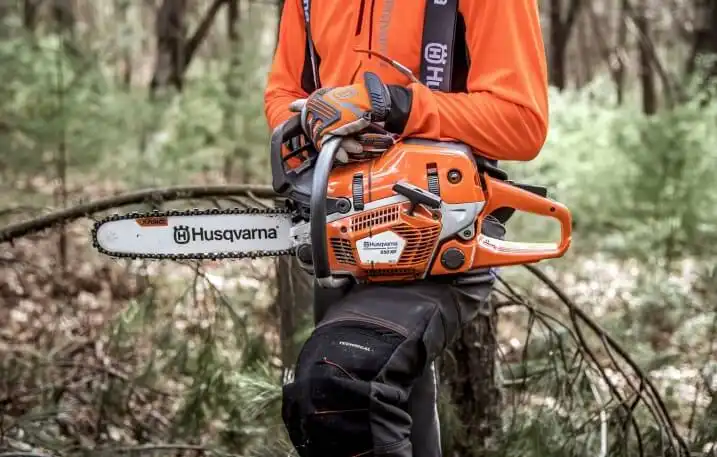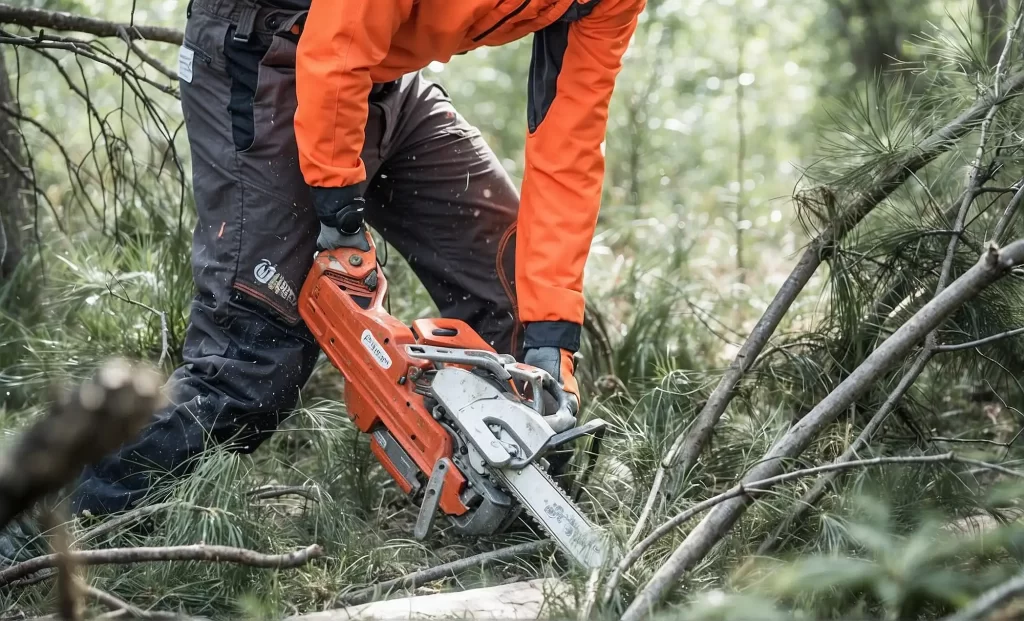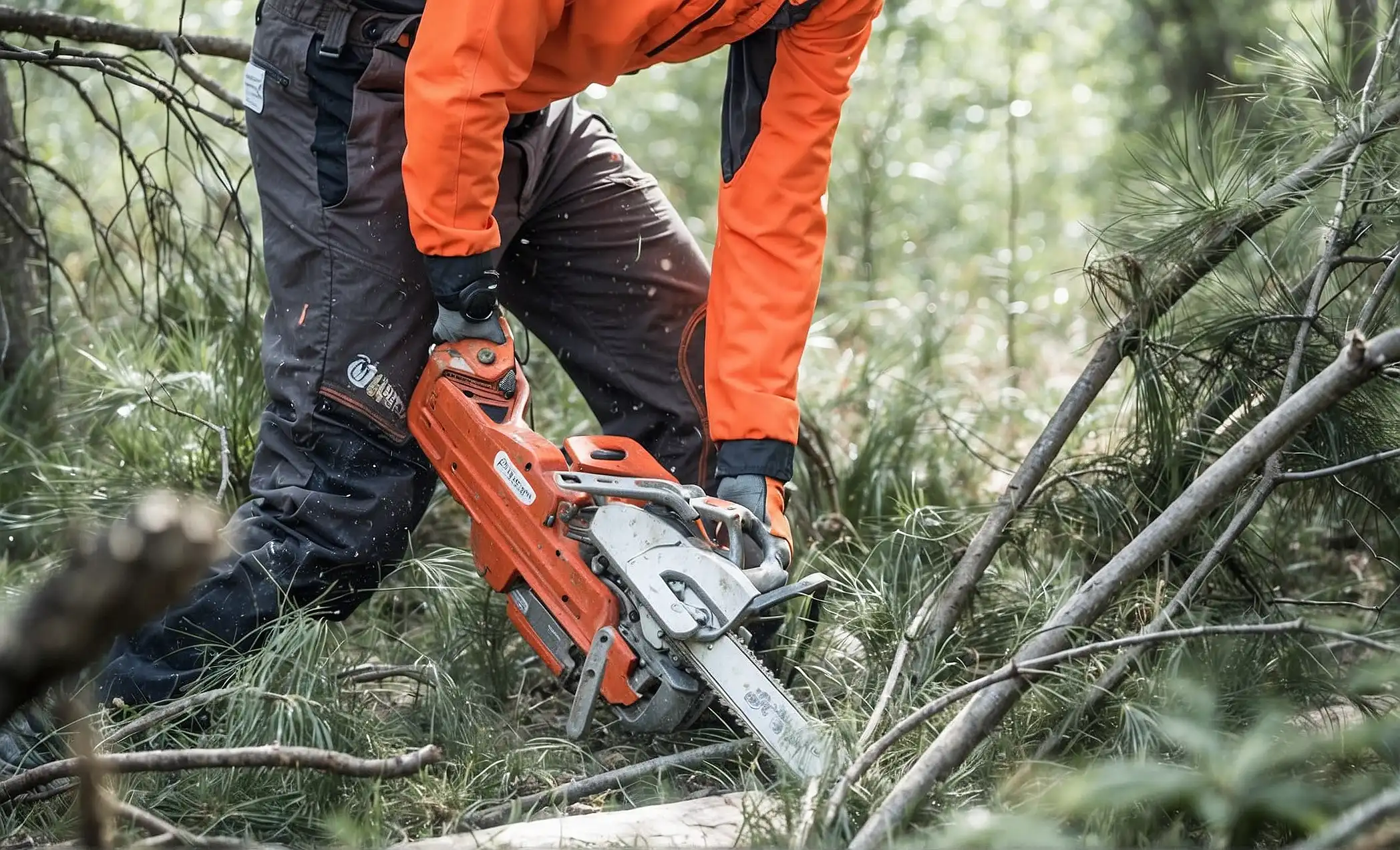To use a chainsaw on wet wood, ensure that the chain is sharp and the tension is properly adjusted. Employ steady pressure and avoid forcing the chainsaw through the material.
Cutting wet wood with a chainsaw can be a challenging task, but with the right approach, it’s manageable. Dealing with wet lumber requires extra caution since the moisture content can affect the cutting process. Before you start, double-check your chainsaw’s condition; a well-maintained tool is crucial for efficient and safe operation.
A sharp chain not only cuts better but also reduces the risk of the chainsaw getting stuck or causing kickback. Safety gear, including gloves, goggles, and a hard hat, is essential to protect you from potential hazards. Remember to follow the manufacturer’s guidelines for use and maintenance, as well as any safety instructions specific to cutting wet wood to ensure a smooth and accident-free experience.

About Chainsaw Usage on Wet Wood
Chainsaws are versatile tools for cutting wood, yet wet wood presents unique challenges. Understanding how to tackle these can ensure a smooth and safe experience. This guide explores the essentials for using a chainsaw on wet wood effectively.
Understanding the Challenges of Wet Wood Cutting
Cutting wet wood with a chainsaw is not straightforward. Wet wood is heavier and more prone to pinching the saw’s blade. It also promotes rapid dulling of the chainsaw teeth. Taking these factors into account is crucial for efficient and safe operation.
The Importance of Proper Equipment and Techniques
Proper equipment and techniques are vital. A chainsaw with the right specifications and a sharp blade can make a significant difference. Employing the correct cutting technique ensures that the task proceeds smoothly and with minimal risk to the user.
- Use a chainsaw with adequate power.
- Keep chains sharp and well-oiled.
- Apply steady, even pressure while cutting.
- Ensure personal safety gear is worn at all times.
Preparing to Cut Wet Wood With a Chainsaw
Facing wet wood in your path? A chainsaw can be a mighty ally, but preparation is key when cutting through soaked timber. Below, uncover how to gear up and get the job done.
Selecting the Right Chainsaw for Wet Conditions
Choosing a suitable chainsaw is crucial for safety and efficiency. Ensure a sharp chain and powerful engine for seamless cuts through wet wood. Opt for chainsaws designed for all-weather conditions. Look for features like waterproofing and a non-slip grip.
Personal Protective Equipment (ppe) For Wet Wood Cutting
Safety first. Wet conditions demand extra caution. Gear up with:
- Waterproof gloves: Keep your grip firm and hands dry.
- Anti-slip boots: Stability is a must on slippery surfaces.
- Chaps or cut-resistant pants: Protects legs from accidents.
- Helmet with face shield: Defends against flying debris.
- Hearing protection: Chainsaws are loud, protect your ears.
Assessing the Wood and Environment for Safety
Examine the scene before you start. Look for:
| Environment | Wood Condition |
|---|---|
| Stable ground | No metal or rocks in wood |
| Clear area around wood | Check for rot or splits |
| No bystanders nearby | Ensure wood is secure |
After thorough preparation, a powerful, precise cut through wet wood is just a step away.
Techniques For Cutting Wet Wood Effectively
Cutting wet wood with a chainsaw requires specific techniques. Unlike dry timber, wet wood presents unique challenges. Proper methods ensure a clean cut without damaging your chainsaw. Let’s delve into some effective tips for handling wet wood.
Proper Chainsaw Handling and Posture
Maintaining balance and control is critical when using a chainsaw, especially on wet wood. Here’s how:
- Stand firm: Plant your feet solidly on the ground.
- Bend your knees slightly: This provides stability.
- Hold the chainsaw close to your body: This improves control.
- Use both hands: Always grip the chainsaw with both hands.
Adjusting Cutting Techniques For Wet Conditions
Wet wood requires adjustments to your cutting technique. Focus on these adjustments for smoother cuts:
- Reduce speed: Slower cutting prevents the chainsaw from slipping.
- Apply steady pressure: Let the chainsaw do the work without forcing it.
- Check chain tension: A properly-tensioned chain ensures efficient cutting.
Avoiding Common Mistakes When Cutting Wet Wood
Common errors can lead to poor cuts or damage. Avoid these mistakes:
- Don’t rush: Take your time to ensure the safety and longevity of your chainsaw.
- Keep blades sharp: Dull chains make cutting wet wood harder and more dangerous.
- Avoiding twisting: Twisting while cutting can cause kickback.

Maintaining Your Chainsaw After Use on Wet Wood
Using a chainsaw on wet wood requires extra care. Wet wood can lead to additional wear. It’s essential to maintain your chainsaw afterward to keep it in top shape. Pattern your routine with a systematic approach. A well-maintained tool ensures durability, safety, and performance.
Cleaning and Drying Your Chainsaw Post-use
Cleaning your chainsaw is crucial after cutting wet wood. Moisture and residue can cause corrosion. Take these steps:
- Remove loose debris: Brush off sawdust and wood chips.
- Clean the bar: Wipe the guide bar with a rag. Remove oil and sap.
- Inspect the air filter: Clean or replace it if dirty.
- Dry completely: Ensure no moisture remains on the chainsaw to prevent rust.
Sharpening the Chain and Other Maintenance Tips
Sharp chains cut better and stay safe. Check the chain’s sharpness after use. Other maintenance tips include:
- Sharpen the chain: Use a file or a sharpener for a precise edge.
- Oil the chain: Apply quality oil to maintain smooth movement and prevent wear.
- Check the tension: The chain should snap back, not sag.
- Review safety features: Ensure chain brakes and other safety mechanisms function well.
Storing Your Chainsaw to Prevent Damage
Proper storage extends the life of your chainsaw. Follow these steps to prevent possible damage:
- Use a proper case: Protect your chainsaw from dust and dampness.
- Choose a dry location: Store in a low-humidity area to avoid rust.
- Drain the fluids: Empty the oil and fuel to prevent leaks and degradation.
Learn more: Stihl Ms400 Problems & Solutions
Safety Considerations and Best Practices
Chainsaws are powerful tools, making light work of cutting tasks. But safety should always come first, especially with wet wood. Understanding the risks and adhering to best practices guarantee a safer experience for all involved.
Understanding the Risks of Kickback With Wet Wood
Kickback is when the chainsaw suddenly jolts towards the user, posing grave risks. Wet wood can cause the chainsaw to slip or stick, increasing these risks. Proper handling is crucial to minimize accidents. Using specific chains designed for wet conditions can make a significant difference in maintaining control over the chainsaw.
Routine Checks and Balances For Continued Safety
- Inspect your chainsaw before each use, especially the chain tension and sharpness.
- Wear appropriate safety gear: gloves, goggles, non-slip boots, and ear protection.
- Ensure the working area is clear to avoid tripping over debris.
- Regular maintenance such as cleaning the chainsaw keeps it in optimal condition.
Learning From Experts: Tips and Tricks for First-Timers
For those new to using a chainsaw on wet wood, it’s important to absorb wisdom from seasoned experts. Key tips include:
- Start with a smaller chainsaw for better control.
- Practice on dry wood before attempting to cut wet wood.
- Engage low power when initiating the cut to gauge the wood’s resistance.
- Always have a partner nearby in case of emergencies.
Conclusion
Cutting wet wood with a chainsaw can be challenging, yet it’s manageable with the right techniques. Prioritize safety, maintain your equipment, and use the proper cutting method. Remember to let your chainsaw dry post-use to prevent rust.
Dive deeper into the chainsaw world with Chainsaw Hive. Our Knowledge section brings you the latest and greatest in chainsaw lore. Happy and safe cutting!
